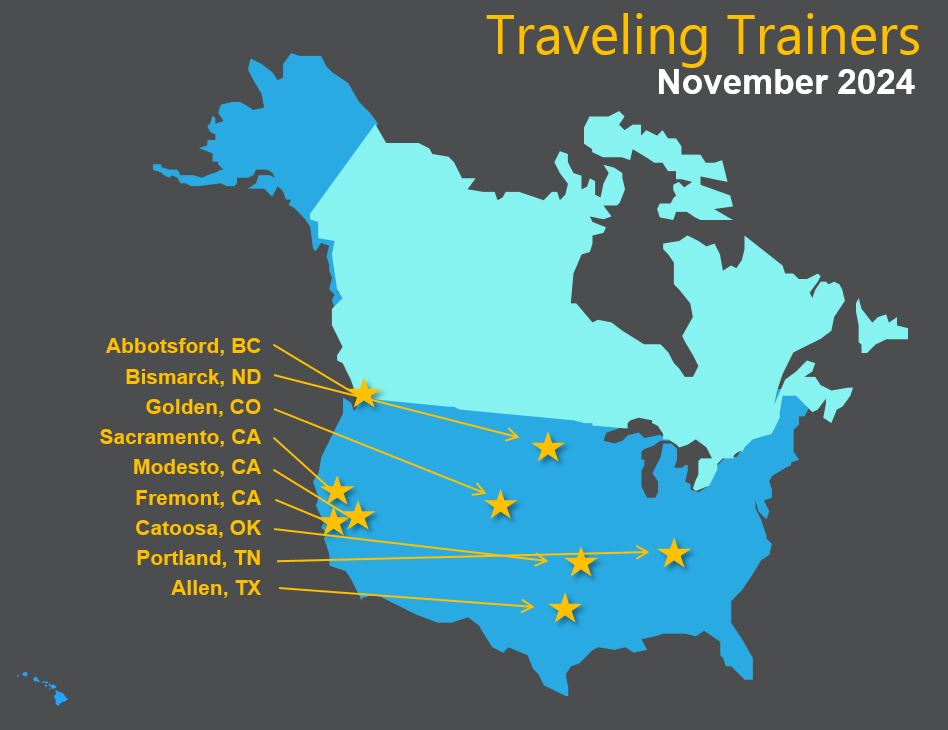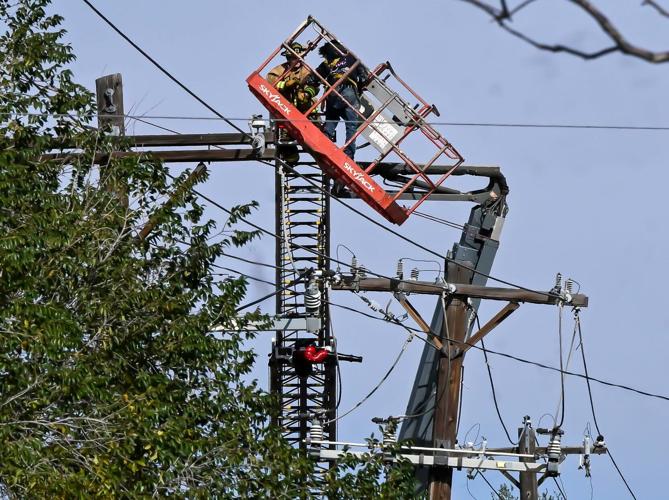
The IVES Update Newsletter is a highly informative monthly e-newsletter. It contains up-to-date industry information, regulatory updates, stories from the field, upcoming program dates, What’s Wrong With This? photos, incident reports, our interactive “Ask Bob” question and answer column, new product details and much more.
Whether you're interested in forklifts, mobile elevating work platforms, loaders or excavators – we’ve got you covered. Want to receive it directly to your inbox? Sign up for our IVES Update e-Newsletter!
Year:

Imagine this scenario: A company has experienced significant turnover, and many seasoned employees have left.Suddenly, the supervisor considers one remaining employee as the most knowledgeable point of contact and assigns a task that they haven’t performed in nearly a year. The supervisor doesn't know when the employee was last trained on the task or completed it; he only knows the employee meets the company's training requirements and is the most tenured in the department. On paper, the employee is "qualified," but the real question is whether they are still competent to handle the task safely after such a long time.
This situation highlights a common issue observed in many organizations. Employees are asked to conduct tasks, yet they have knowledge deficiencies on the topics because of the long gaps between when they were trained and when they last applied the information or skill. However, in the event of an incident, the findings usually do not point to the system training flaw. instead, human error is the usual suspect. The conclusion is that the employee was trained on the topic and should have known better.
Many people have observed this issue in their careers. But how did it become common throughout most organizations? The situation is complex, but in a simple response, employers tend to assume that once their employees are trained on a safety topic, they have the knowledge to deal with it at any given time. There are several contributing factors as to why that assumption is there, including a lack of understanding of the topics of adult learning principles and human performance improvement strategies. Rather, it assumes a one-size-fits-all training method works for all training topics or overly relies on the instruction provided in the standards.
The goal is to get organizations out of the old mind frame of believing that simply following the training requirements in the standards is sufficient to ensure competence. Too often, the focus is on ensuring workers are trained to meet minimum regulatory requirements, with little emphasis on continuous learning to keep knowledge and skills sharp. It is crucial to recognize that compliance does not equal competence. A compliant employee may have passed the necessary safety training courses but could present a hidden risk if they have not regularly used the knowledge or practiced their skills.
One of the biggest challenges with training in general is how quickly people forget what they've learned if they don't use it. Too often, an employee attends training and numerous topics are covered, but they still do not apply the knowledge or working skill weeks after the training concluded. Also, factor in the knowledge overload that employees are experiencing as they are expected to retain knowledge on craft or task-specific skills, company policies, software, equipment use and more, in addition to safety protocols. Employers must understand that expecting employees to recall everything from a single or every-so-often safety training session is unrealistic. Research shows that, without reinforcement, up to 90 percent of new information is forgotten within a month. This underscores the need for continuous learning, especially with safety training.
Continuous education and practice are vital for maintaining knowledge and skills. Whether working on a ship, coaching athletes or teaching students, constant practice leads to excellence. Regular training and drills ensure that our working knowledge and critical skills become second nature. Repetition ensures learning objectives stick and skills remain sharp. The same should apply to safety training, where refreshed knowledge can mean the difference between safe operations and incidents leading to serious injuries or fatalities. Some safety compliance training might require a refresher every two to five years or it may be a one-time event. These training gaps create risks, especially in complex work environments where employees must perform tasks they haven't practiced in a long time.
Organizations must rethink safety training, treating it as an ongoing learning process rather than a check-the-box exercise. Studies show that when employees rely solely on memory recall for complex tasks, their error rate can increase by as much as 50 percent, with dangerous consequences. Without ongoing learning, workers may struggle to recall essential details when it matters most. OSHA also recognizes this issue. For instance, under OSHA 1910.269, employers must provide initial training to workers and ensure that they are assessed or retrained at least annually to maintain safety competency.
When organizations embrace continuous learning, they foster a culture of safety. A learning model with frequent training refreshers that incorporates a combination of instructor-led, computer-based, mini-module, practical applications, toolbox talks, on-the-job or task familiarization guidance, and real-time task feedback helps bridge knowledge gaps. This shift from compliance-driven to competence-driven training can make a difference in preventing accidents and ensuring a safer workplace.
In summary, we need to rethink safety training. Meeting compliance standards does not guarantee employees fully understand the safety practices they are dealing with, just as complying with OSHA standards does not necessarily mean workers are protected. Organizations should view safety training as a continuous improvement project where worker knowledge and skills are constantly gauged and not a one-time or occasional event. Just as a sports team cannot succeed by practicing once a year, we cannot expect employees to perform at their best based on one-time training or information they received years ago.
Source: OHS Oct 2024
 An OSHA workplace safety investigation has found that a Huntsville, Alabama countertop installation company could have prevented a 33-year-old employee from being struck by a stone slab weighing thousands of pounds by following federal safety standards at a Huntsville job site.
An OSHA workplace safety investigation has found that a Huntsville, Alabama countertop installation company could have prevented a 33-year-old employee from being struck by a stone slab weighing thousands of pounds by following federal safety standards at a Huntsville job site.
OSHA investigators determined that employees of Huntsville Granite and Marble LLC were using a forklift to take stone slabs off a storage rack when the slab became unsecured and struck the worker. OSHA found that an improperly secured load and a damaged rigging hook with a missing safety latch contributed to the incident.
OSHA determined the company violated federal regulations by doing the following:
“Huntsville Granite and Marble didn’t uphold its duty to keep workers safe,” said OSHA Area Office Director Joel Batiz in Birmingham, Alabama. “With the right procedures, equipment, and training, this tragedy could have been avoided. We call on employers to make workplace safety a priority and use OSHA resources to safeguard their employees.”
OSHA issued five serious citations to Huntsville Granite and Marble for violations related to its failures to protect workers from struck-by, crushed-by and fall hazards. OSHA has proposed $29,035 in penalties to address the violations, an amount set by federal statute.
Source: ISHN Oct 2024
Digital Training Aids are designed specifically to complement our Operator Reference Manuals and are available in downloadable or internet versions. These graphic training aids are a stunning slide show collection of the most accurate and colorful imagery on the market today.
¿Hablas Español? Select Digital Training Aids are also available in Spanish.
Volume discounting is available for select products - save up to 40%!
I just want to ask about classes of forklift.
In our warehouse, we do have classes 1 (electric), 4 (cushion tires) and 5 (pneumatic tires).
In my previous trainings, I just put on the paperworks/certificates "Class 4" because that's the type of forklift that we used for the training.
I don't know if I need to put Classes 1, 4 & 5 on the training since we all drive those kinds of forklifts?
A: That’s an excellent question, thanks for sending it.
Before I answer it though, I’d like to address another issue here and that’s using one classification of forklift for training and evaluation when three are actually involved.
If the various classes of forklifts your people use are all more or less the same, meaning that they have similar operating characteristics and control layouts, and work attachments, then it’s fine to do as you did and just use one.
However, you must be sure to address any significant differences between them and make sure operators can work with them when they need to.
For example, you use classes 1,4 and 5 machines at your workplace but only used the class 4 during training, but did you make sure the trainees knew how to charge the battery (for example) on the class 1 if that is something they are expected to do?
To summarize here, it’s fine to use one type of machine for training/evaluation if the other types they may use are similar. But you absolutely do need to address any significant differences between them and make sure it is documented.
Which brings me to your original question on documentation.
I would suggest getting away from just listing only the class 4 in the documentation as you definitely want to have it on record that you addressed all three types.
On the Wallet Card, you should list “Class 1-4-5” under “Equipment Classification” and just “Standard Forklift” under “Equipment Name.” Do the same on the Certificate of Completion where the equipment types are listed.
On the Practical Evaluation form, just the machine you used for the evaluation should be listed, which in your case is the class 4.
On the Record Sheet (back of the folder), enter the information as it relates to the class 4 only – because that was the only one you used. However, in the NOTES section on the inside cover of the folder, you should record that although only the class 4 was used for practical training and evaluating, the class 1 and 5 were also addressed in the classroom. If you actually did do any specific practical training/evaluating on the other two, like walking through the battery charging procedure on the class1 or checking the tire pressure on the class 5, record it here.
Be detailed, record the makes and models of the class 1 and 5 as well the specific topics addressed and any evaluations/exercises conducted.
Once again, you can do what you did and just use one type of machine for the practical evaluation, but if your documentation only a class 4 machine listed, that is all they are qualified to operate in the eyes of regulatory authorities

 "I love the interaction and discussion as a class. It is tremendously useful and enlightening."
"I love the interaction and discussion as a class. It is tremendously useful and enlightening."
Tim D, Premium Combo Train the Trainer Certification
"Great course, great way to setup first time trainers to understand programs and build confidence. Helped me rethink the way I train my other programs."
Chris H, Premium Combo Train the Trainer Certification
"This class exceeded my expectations and was very detailed. Information I received in this class will help me on a daily basis."
Josh H, Custom Program Train the Trainer Certification
copyright © IVES Training Group 2022 All Rights Reserved.